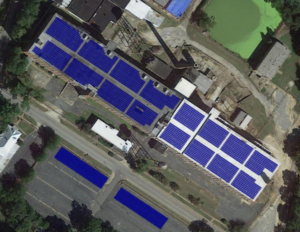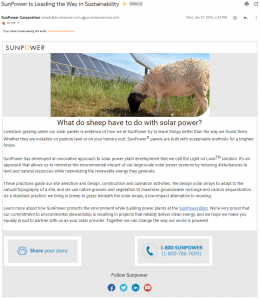Fw: Middleburg Plaza O&M
Inbox

| Matt Warren <matt.warren@hannahsolar.com> |  Jul 15, 2016, 6:09 PM Jul 15, 2016, 6:09 PM |   | |
to me |
From: Mary Britton
Sent: Friday, July 15, 2016 6:08:19 PM
To: Mark Cann
Cc: Matt Warren
Subject: RE: Middleburg Plaza O&M
Mark – I didn’t really have that much info to include since you wanted to combine the systems and there are several owners. I will leave as a word document in case you want to edit. I am happy to make changes Monday as well.
Here are the main details of any O&M contract. Working on sending out a blank presentation to you all this weekend.
Let me know if you need anything else.
Matt – nice to meet you over email.
Hope you both have a great weekend.
Cheers,
Mary
Mary Britton
Hannah Solar, LLC
Director of Service
(404) 554-8511 – Direct
(404)747-7241 – Mobile
From: Mary Britton
Sent: Friday, July 15, 2016 5:54 PM
To: Mark Cann <mark.cann@hannahsolar.com>
Cc: Matt Warren <matt.warren@hannahsolar.com>
Subject: RE: Middleburg Plaza O&M
Mark – please see the attached O&M proposal for 5 and 10 yr. options for Middleburg, working on the other one now.
Thanks,
Mary
Mary Britton
Hannah Solar, LLC
Director of Service
(404) 554-8511 – Direct
(404)747-7241 – Mobile
From: Mark Cann
Sent: Thursday, July 14, 2016 1:39 PM
To: Mary Britton <mary.britton@hannahsolar.com>
Subject: Middleburg Plaza O&M
Mary,
I need an O&M presentation and quote for Middleburg Plaza in Columbia SC. It is 195KW roof mount. I do not have the address handy but just need a number for 5 and 10 years please and the presentation. Thanks
Mark Cann
Business Development
Hannah Solar, LLC
1311 Collier Rd.
Atlanta GA 30318
Office: 404-609-7005
Cell : 864-706-3930
What does it take for solar installers to provide O&M services?
By SPW | July 6, 2016FacebookTwitterLinkedInPinterest
By Laks Sampath, country manager of U.S. & Latin America for global solar O&M firm Alectris

Laks Sampath
Global solar installations are expected to reach 321 GW by the end of 2016, exceeding 756 GW by 2025. As the world’s inventory of solar PV assets grows, it is not surprising to see those industries related to post-installation—operations, maintenance and asset management—exploding as well.
This explosion of solar PV systems of all sizes around the world is driving the need for cost-effective O&M practices and company specialization to ensure best practices and superior plant performance.
While the solar O&M market got its start when EPC companies needed to service the installations they built, the landscape is changing. Lately, the market is moving in favor of independent service providers (ISPs). This can be attributed to the maturation of the market and the need for specialized service offerings. The level of complexity for O&M and asset management grows as the size of the install increases, with utility-scale installations requiring a sophisticated suite of services to manage and onboard large amounts of power onto the grid.
But for those installers looking to add O&M to their service offerings, here are the basics on how to get started.
Cost Factors of In-House Solar O&M
If installers are interested in providing solar O&M services or expanding on their existing capabilities, there are several areas of functionality that should be reviewed. Can the installers perform plant monitoring, analytics, root cause detection and other reporting functions? Are there dedicated skilled technicians, O&M managers, software/IT experts, financial and accounting personnel available?

There are three basic functions an O&M department is asked to perform:
- Fast problem identification and resolution
- Minimization of down-time due to faults
- Detailed reporting and transparency
In order to determine the company’s ability to comply and even outperform the contractual obligations related to a specific solar project, it is important to define what qualities and competencies are needed to excel in these three functions.
The design or architecture of the O&M provider, whether in-house or outsourced, can be evaluated on three areas of functionality–core systems, supporting systems and management.
Core Systems
This set of properties is absolutely necessary to perform solar PV operations and maintenance services at a minimum. Such core capabilities include:
- DAS (Data Acquisition System): Companies often develop their own proprietary systems or rely on third-party platforms. Contractors who use multiple systems often have a difficult time consistently monitoring their portfolios due to differences in performance of various systems. DASs should be evaluated on specific competences, including small things like lag time between data generation and insertion into the database. It is important to identify how comprehensive a DAS is in terms of devices monitored and also parameters measured on those devices.
- Data Analysis Capabilities: Massive amounts of data is generated from each solar PV plant in a company’s portfolio, and appropriate IT tools must be used to accurately analyze this data. Whether analytical capabilities are integrated in the DAS or are provided by an external tool, the requirements remain the same. Analytical tools can be rated according to their customization and the range of pre-configured analytical reports. One important aspect that needs to be taken into consideration is the reporting on the solar O&M activities performed and their outcome. All the above should ideally be related to as-built data in a hierarchical manner, so that analysis is more meaningful to engineers.
- Field Personnel: The types of field personnel needed to maintain the physical aspects and installation environment of a solar site range from plant security and maintenance to panel cleaning, testing in the field, equipment technicians, electricians, etc. There are specialized services now even within each of these areas. Hiring and managing these resources dictates another level of expertise needed within the solar O&M service area.
- Control Room: The solar O&M control room is the heart of the operations—the command center. The operators in the control room analyze faults and provide the instructions to the field personnel for their interventions. The technological infrastructure of the control room, which is tightly connected with the DAS, analytical tools and CRM, is also of key importance.
- Engineering Capabilities: Engineering capabilities are very often undervalued mainly due to the fact that the role of the solar O&M service provider is often restrained to basic preventative maintenance activities and responding to incidents. The importance of engineering in analyzing deficiencies and proposing technical enhancement is of major importance.

Supporting Systems
Supporting mechanisms required to keep a solar O&M operation running at maximum efficiency include:
- Quality Assurance & Accountability: Like any other service provider, O&M providers have to perform its services at the highest level. Especially in distributed environments, when different teams are getting involved in problem resolution, it is important to measure quality of the services, track activities of people involved and focus on deficiencies through training programs. It is critical to measure such services in an objective way to provide needed insights for management.
- Process Control: Especially when the portfolio consists of geographically distributed solar PV plants, having a tight control on the processes through documented internal processes, written procedures for in-house or outsourced personnel is necessary to ensure all activities are executed according to exact plant, O&M plan and budget specifications.
- Knowledge-base of Problem Resolution: Solar PV plants are similarly constructed regardless of their location. There are few technological differences, and the vast majority of arising issues tend to be very similar. Building a centralized knowledge-base of issues dealt with (and resolved) in the past can be a significant help for engineers, operators and field personnel to increase efficiency and speed of problem resolution.
- Tracking Activities and Measurements by Field Personnel: Although a DAS captures vital data from all devices in a solar plant, this alone does not provide a holistic view of the PV system, since throughout the duration of an O&M contract a variety of activities are performed. Apart from simple tasks and preventative maintenance, the service provider may perform a wide range of field measurements to analyze and troubleshoot faults. Such measurements are valuable data contributing to the understanding of a plant behavior. Every service ticket and steps taken to resolve issues are critical to ensuring corrective and preventive maintenance activities are recorded and preserved.
Management
Skilled professionals are required to manage a solar O&M discipline within a company. Typically having an engineering and/or deep solar PV background, they oversee the plant maintenance activities starting at the onset to manage the handoff of newly constructed solar plants from construction to O&M. They are responsible for in-house technicians or outsourced subcontractors in every area of maintenance. They oversee warranty part inventory. Their responsibilities include the control room and IT functionality and asset management reporting, along with department reporting.
The complexity of solar operations, maintenance and asset management, including the need for robust software support, demands a sophisticated approach to plant operational health. This may or may not be feasible within the average installer’s capabilities. An objective review of what is truly required will shed light on the feasibility of delivering a full suite of O&M services in-house.
Access the Alectris’ White Paper: “Evaluating the O&M Contractor” for more information.

